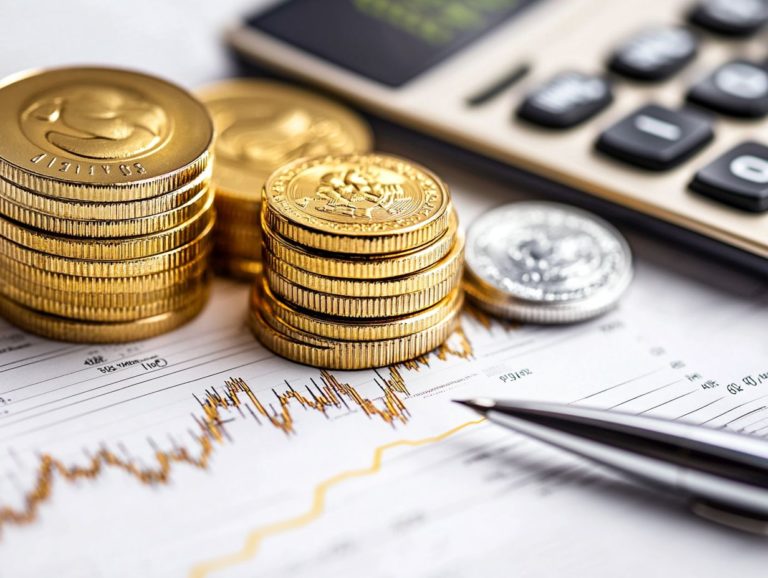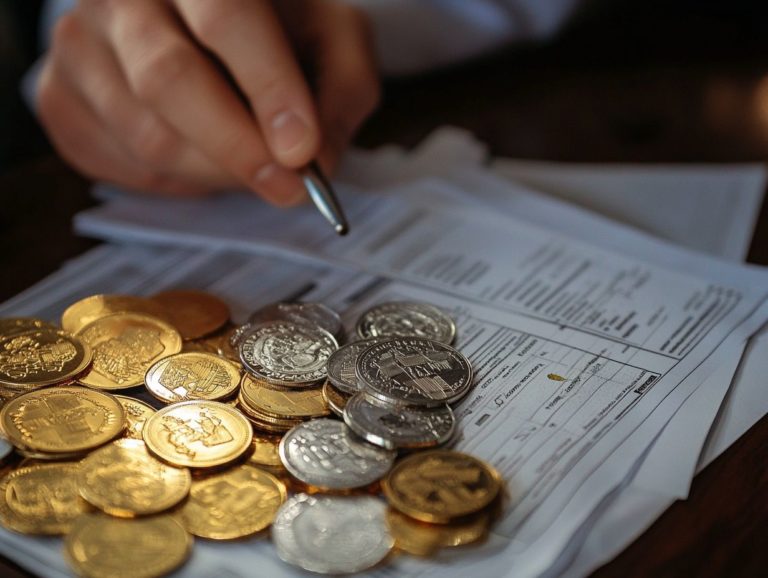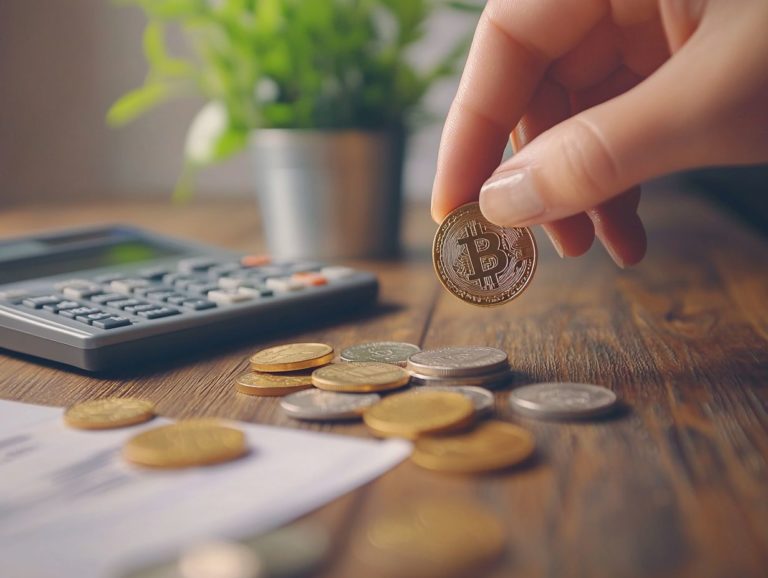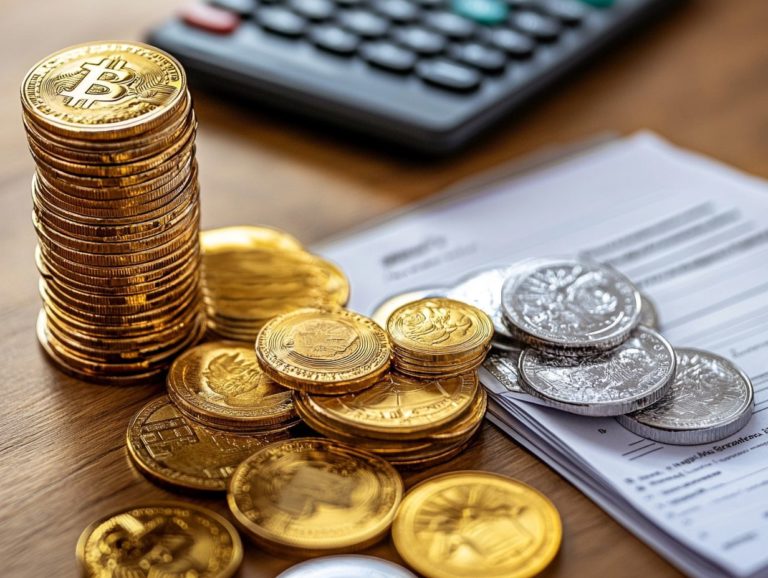Navigating Tax Regulations for Precious Metals Investments
Investing in precious metals can be rewarding, but it also has complexities, particularly regarding taxes.
Familiarize yourself with different metals and their values. Understand how taxes affect your financial strategy.
This guide explores precious metals investments. You will learn about benefits, tax regulations, and strategies to reduce your tax burden.
Whether you re an experienced investor or a beginner, this overview provides essential knowledge for informed decisions.
Contents
- Key Takeaways:
- Understanding Precious Metals Investments
- Tax Implications of Precious Metals Investments
- Navigating Tax Regulations for Specific Metals
- Strategies for Minimizing Taxes on Precious Metals Investments
- Frequently Asked Questions
- What are the tax implications for investing in precious metals?
- Are there any exceptions or special tax treatments for investing in precious metals?
- How do I report my precious metals investments on my tax return?
- Can I deduct any expenses related to my precious metals investments on my taxes?
- What Happens If I Inherit Precious Metals?
- Are There Any Tax Breaks for Investing in Precious Metals?
Key Takeaways:

- Precious metals offer protection against inflation and economic uncertainty but come with tax responsibilities.
- Understand the different capital gains tax rules for each metal to navigate regulations effectively.
- Consider strategies like selling losing investments to offset profits. Consulting a tax professional is wise for personalized advice.
Understanding Precious Metals Investments
Understanding precious metals investments is vital for diversifying your portfolio. These metals provide a hedge against economic uncertainty.
Gold, silver, platinum, and palladium maintain value over time. They serve as both a store of wealth and a strategic asset in various markets.
Their value comes from their limited supply, protecting against inflation and currency changes. Their historical significance shows their evolving role in finance and personal investments.
Types of Precious Metals and Their Value
The key precious metals to watch are gold, silver, platinum, and palladium. Each has unique properties that appeal to various investors.
Gold is a safe haven during uncertainty, symbolizing wealth and serving as a monetary benchmark. Silver’s versatility in industry and investment attracts a broad market, especially with rising tech demand.
Platinum and palladium may be less known but are valuable due to their limited supply and roles in cleaner vehicle emissions. Demand can fluctuate dramatically with geopolitical issues, inflation, and mining changes.
Consider the historical significance of these metals. Their long tradition provides insight into their stability and price trends.
Why Invest in Precious Metals?
Investing in precious metals offers advantages like diversification and tax benefits. These tangible assets often retain or gain value during financial crises.
Given market volatility, it s smart to consider allocating part of your portfolio to these metals. The potential tax benefits further enhance their attractiveness in a balanced portfolio.
Incorporating these investments protects your wealth and creates opportunities for growth, ensuring long-term financial security.
Tax Implications of Precious Metals Investments

Understanding the tax implications of precious metals investments is crucial for you to effectively navigate potential tax liabilities, such as capital gains tax, sales tax, and wealth tax.
In the United States, the IRS classifies precious metals as collectibles, which means they are subject to different tax rules compared to other investments. This classification can greatly influence your overall return on investment, depending on factors like the holding period and how you structure your transactions. For more on this topic, consider exploring tax strategies for precious metals in today’s market.
By familiarizing yourself with these regulations, you can make informed decisions about reporting requirements and identify potential exemptions that may apply to your investments.
Capital Gains Tax on Precious Metals
Capital gains tax on precious metals is a significant aspect for you as an investor, impacting the profitability of your investments based on how long you’ve held them and the nature of your sale.
Grasping the intricacies of this tax can empower you to navigate your investment strategies with greater precision. For example, while many assets fall under the general long-term capital gains tax rates, precious metals like gold and silver are often categorized as collectibles, subjecting you to a higher tax bracket. Understanding the tax effects of precious metals investments will help you make informed decisions.
Collectibles face a maximum tax rate of 28%, which is notably steeper than the standard long-term rates of 15% or 20% that apply to other assets. Thus, it s essential for you to evaluate your holding period carefully. If you hold assets for more than a year, you might pay less tax if they fit into different classifications.
To effectively minimize your tax liabilities, consider strategies such as offsetting gains with losses or exploring tax-advantaged accounts, which could prove advantageous for your financial health.
Reporting Requirements for Precious Metals Investments
As a precious metals investor, you must navigate specific reporting requirements set by the IRS, including completing Form 8949 and Schedule D for calculating capital gains. This compliance is vital to protect your investments!
When you sell or exchange precious metals, it’s crucial to report these transactions meticulously. You’ll need to document details like purchase and sale dates, amounts, and any associated costs. For instance, when selling gold coins, it’s essential to understand what to know about international tax on precious metals; forgetting to report the profit could lead to serious penalties!
Be mindful that certain exchanges may issue Form 1099-B for your metal sales, which amplifies the need for diligent record-keeping to ensure you capture all relevant information accurately. Understanding these nuances, including the tax obligations of precious metals, can help you mitigate risks and promote compliance, setting you up for a smoother investment journey.
Navigating the tax regulations surrounding specific metals like gold, silver, platinum, and palladium is essential for you as an investor. It enables you to ensure compliance and optimize your investment strategies.
Each precious metal comes with its own set of tax rules, both within the United States and internationally, especially concerning foreign regulations that can impact transactions between parties from different countries. By grasping these nuances, you can structure your transactions effectively while adhering to the diverse legal frameworks that govern these valuable assets, including understanding tax reporting for precious metals investments.
Gold, Silver, Platinum, and Palladium

Gold, silver, platinum, and palladium each come with unique tax regulations that you need to grasp to truly maximize your investment potential.
Each precious metal has a different classification under tax law. This can affect sales tax and capital gains tax.
While you may see gold and silver as traditional investments, the tax treatment for platinum and palladium tends to be more intricate due to their industrial applications.
Holding these assets for a certain period may change your capital gains tax liabilities, impacting your overall return on investment.
You might not realize that certain sales can be exempt from sales tax, depending on specific state laws related to these metals.
Understanding the regulations governing each metal gives you the power to make informed decisions and could potentially lead to significant savings on taxes.
Strategies for Minimizing Taxes on Precious Metals Investments
Start using smart strategies now to minimize taxes on your precious metals! This can dramatically boost your returns.
Techniques such as tax-loss harvesting (selling investments at a loss to reduce taxes) and meticulous structuring of transactions to align with reporting requirements are key to optimizing your investment outcomes.
Tax-Loss Harvesting and Other Techniques
Tax-loss harvesting is an invaluable strategy for you if you’re keen on minimizing taxes on your precious metals investments by offsetting capital gains (the profit from selling an asset) with losses from other assets.
This approach involves selling underperforming investments at a loss to counterbalance the gains you’ve realized from more successful ones. For instance, if you’ve enjoyed significant profits from your stocks but have faced losses in your bond investments, you can sell those bonds to capture those losses.
By taking this step, you can effectively reduce your overall taxable income, potentially leading to significant savings on your tax bill.
Timing is essential; executing these sales before the year’s end enables you to report those losses in the current tax year, ultimately enhancing your financial situation as you strategize for future investments.
Frequently Asked Questions
What are the tax implications for investing in precious metals?

The tax implications for investing in precious metals depend on the type of metal and how it is held. Generally, gains from selling physical precious metals are subject to capital gains tax, while investing in precious metals through an IRA may offer tax-deferred or tax-free growth.
Are there any exceptions or special tax treatments for investing in precious metals?
There are a few exceptions and special tax treatments for investing in precious metals. For example, certain bullion coins, such as American Eagle coins, are considered legal tender and may be exempt from state sales tax. Additionally, investors may be able to take advantage of tax-deferred exchanges, such as a 1031 exchange, when swapping one type of precious metal for another.
How do I report my precious metals investments on my tax return?
Gains from selling physical precious metals must be reported on your tax return as capital gains. If you hold precious metals in an IRA, you will receive a Form 1099-R from your custodian, which you will use to report any distributions or rollovers on your tax return. It is important to keep accurate records of your precious metals transactions for tax reporting purposes.
Deducting expenses related to precious metals investments is typically limited to expenses incurred as part of a business or investment activity. This may include expenses for storage, insurance, or transportation of the precious metals. However, if you sell your precious metals at a loss, you may be able to deduct the loss on your tax return.
Consult a tax professional for personalized advice on your precious metals investments!
What Happens If I Inherit Precious Metals?
If you inherit precious metals, you could face estate or inheritance taxes based on their value and your state’s tax laws.
Selling these metals may also trigger a capital gains tax, which is a tax on the profit made from the sale.
Don t miss out! Consult a tax professional to get tailored advice on managing your inherited precious metals.
Are There Any Tax Breaks for Investing in Precious Metals?
Yes! Investing in precious metals can offer some tax benefits, like tax-deferred growth in a precious metals IRA.
You might also enjoy tax-free gains on certain bullion coins.
Investing in these metals can diversify your portfolio and protect you from inflation.
For the best investment strategy tailored to your tax situation, consult a financial advisor today!















